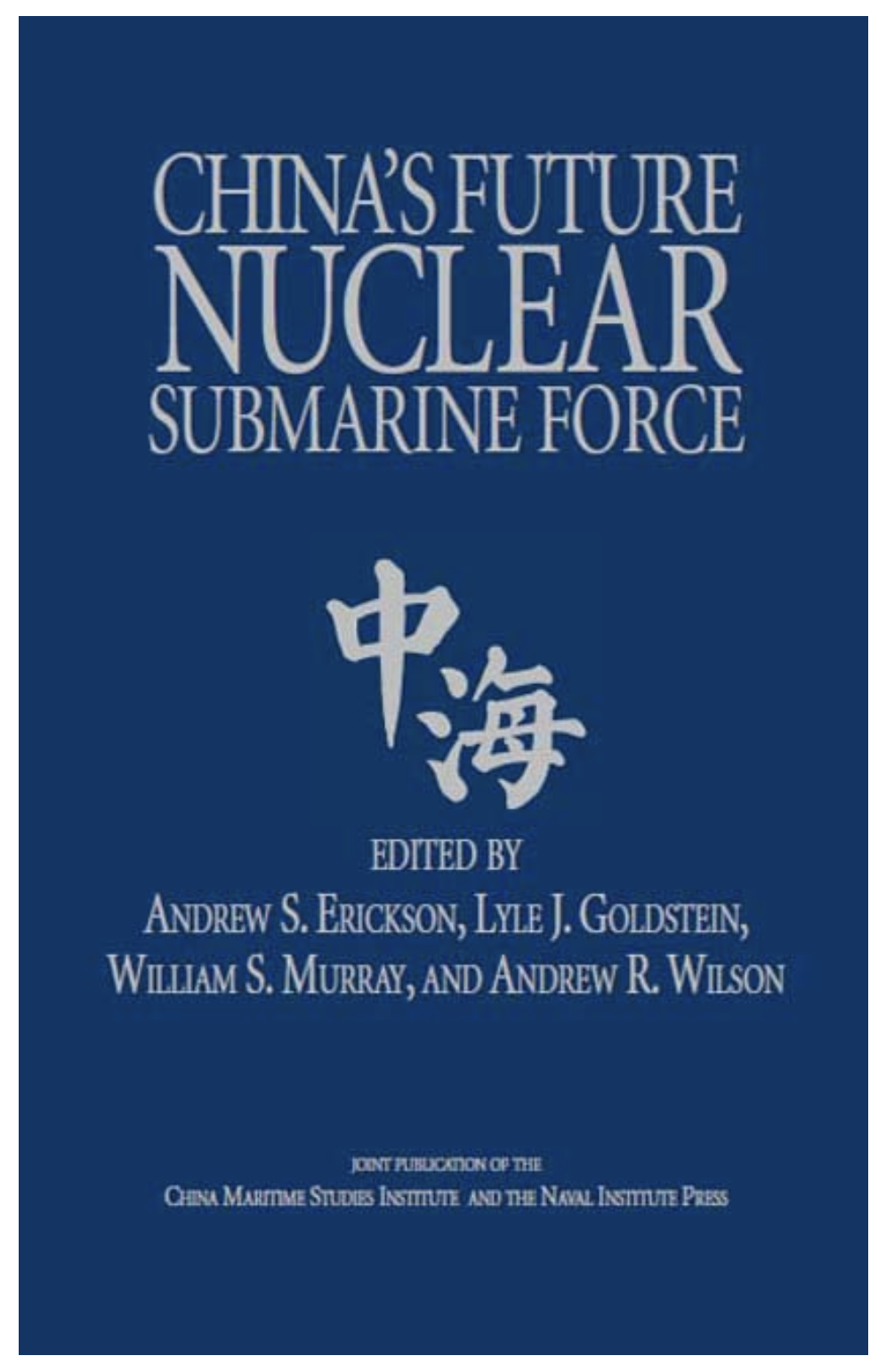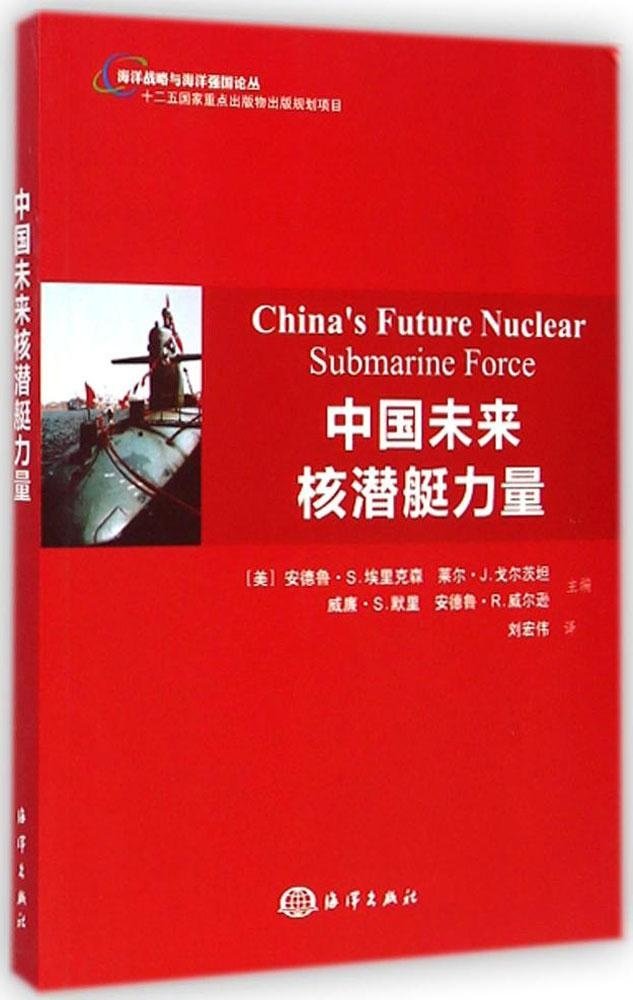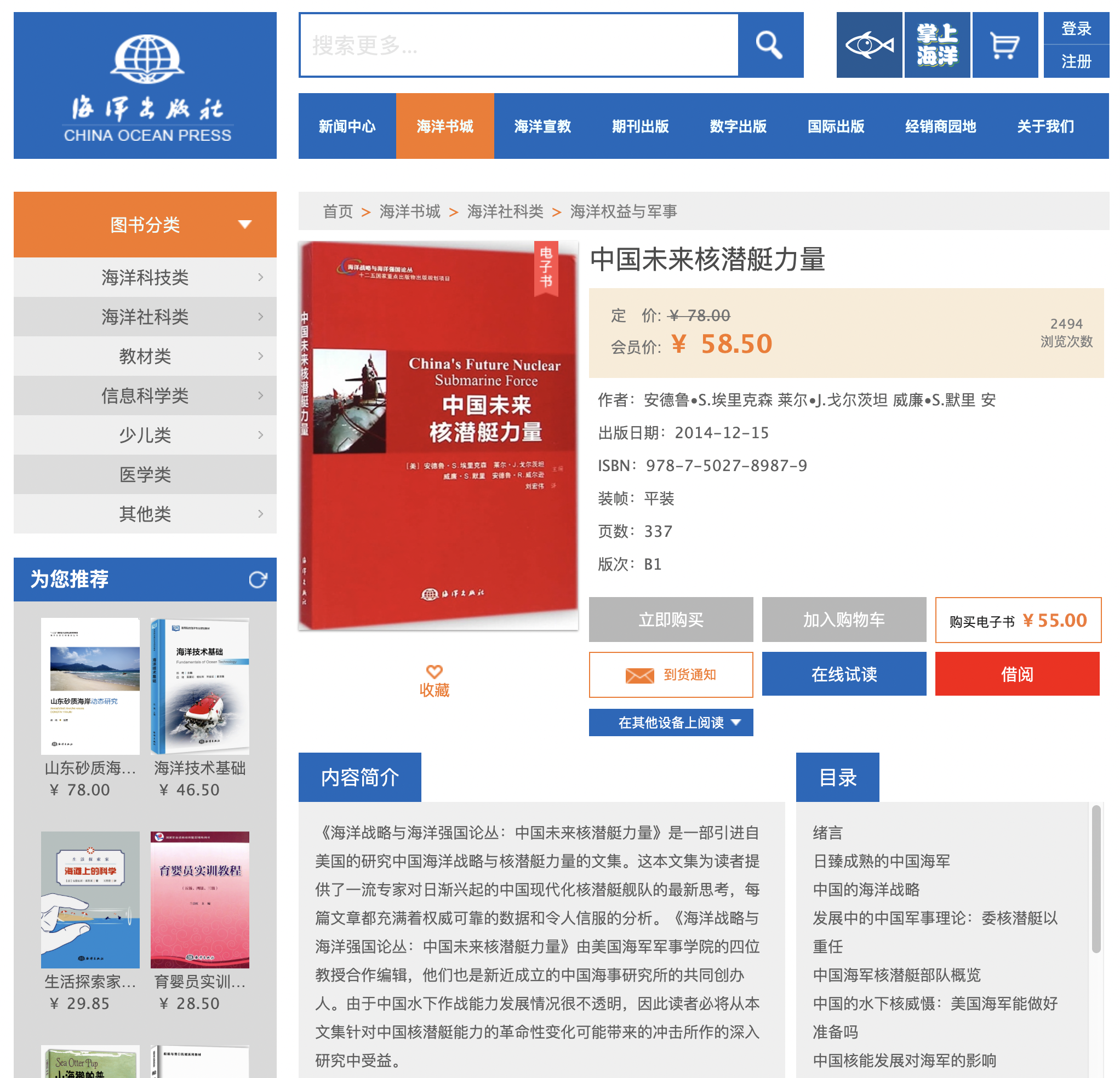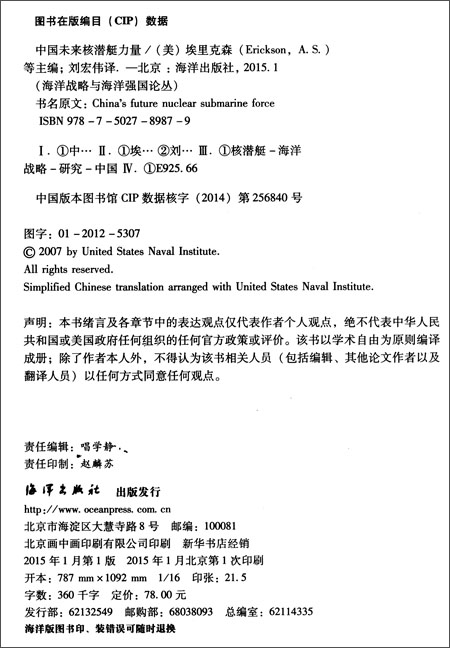China’s Future Nuclear Submarine Force (CMSI Vol. 1)
Andrew S. Erickson, Lyle J. Goldstein, William S. Murray, and Andrew R. Wilson, eds., China’s Future Nuclear Submarine Force (Annapolis, MD: Naval Institute Press, 2007).
- Kindle edition now available!
- These and several other chapters are required reading for the Naval War College Strategy and Policy Department’s Senior and Intermediate Leadership Courses.
- Volume cited in Wikipedia’s “Type 094 Submarine” entry.
Coauthor of:
- Andrew S. Erickson, Lyle J. Goldstein, William S. Murray, and Andrew R. Wilson, “Introduction,” ix–xvi; in Andrew S. Erickson, Lyle J. Goldstein, William S. Murray, and Andrew R. Wilson, eds., China’s Future Nuclear Submarine Force (Annapolis, MD: Naval Institute Press, 2007).
- Andrew S. Erickson and Lyle J. Goldstein, “China’s Future Nuclear Submarine Force: Insights from Chinese Writings,” 182–211.
- Andrew S. Erickson and Andrew R. Wilson, “China’s Aircraft Carrier Dilemma,” 229–269.
Authorized Chinese-language edition published in 2015 by China Ocean Press (www.oceanpress.com.cn):
- Andrew S. Erickson, Lyle J. Goldstein, William S. Murray, and Andrew R. Wilson, “绪言” [Introduction]; in [美] 安德鲁·S·埃里克森 [Andrew S. Erickson], 莱尔·J·戈尔茨坦 [Lyle J. Goldstein], 威廉·S·默里 [William S. Murray], 安德鲁·R·威尔逊 [Andrew R. Wilson], (编者) [Editors]; 刘宏伟 (译者) [Translator]; 中国未来核潜艇力量 [China’s Future Nuclear Submarine Force], 海洋战略与海洋强国论丛 [Maritime Strategy and Maritime Great Power Forum Series], 十二五国家重点出版物出版规划项目 [Twelfth Five-Year Guideline State Key Publications Planning Initiative], (Beijing: 海洋出版社 [Ocean Press], 2015), 1–7.
- Andrew S. Erickson and Lyle J. Goldstein, “中国核潜艇部队的未来: 中国著述的观点” [China’s Future Nuclear Submarine Force: Insights from Chinese Writings], 165–87.
- Andrew S. Erickson and Andrew R. Wilson, “中国的航空母舰困局” [China’s Aircraft Carrier Dilemma], 201–15. PART 1 PART 2
Japanese summary translation now available: “書籍1: 将来の中国原子力潜水艦部隊.”
The trajectory of Chinese nuclear propulsion for submarines may be one of the best single indicators of whether or not China intends to become a genuine global military power. Nuclear submarines, with their unparalleled survivability, remain ideal platforms for persistent operations in far-flung sea areas and offer an efficient means for China to strengthen deterrence and project power.
This collection of essays presents the latest thinking of leading experts on the emergence of a modern nuclear submarine fleet in China. Each contribution is packed with authoritative data and cogent analysis. The book has been compiled by four professors at the U.S. Naval War College who are co-founders of the college’s China Maritime Studies Institute (CMSI).
Given the opaque nature of China’s undersea warfare development, readers will benefit from this penetrating investigation that considers the potential impact of revolutionary changes in Chinese nuclear submarine capabilities. This book is essential reading for everyone interested in China’s foreign and defense policies; in the future of the U.S. Navy; and in the defense of the United States.
This is the first book in the series “Studies in Chinese Maritime Development” published jointly by the China Maritime Studies Institute and the Naval Institute Press.
BLURBS
“Unknowns about China’s Navy, especially its nuclear submarines, perplex our security planners. China’s Future Nuclear Submarine Force presents the most accurate information–and the most savvy analysis–available. This thoughtful compendium is vital to any serious discussion of the PLA Navy.”
–Adm. Joseph W. Prueher, USN (Ret.), Former Commander-in-Chief, U.S. Pacific Command and Ambassador to China
“China’s undersea fleet has been sharply focused on coastal defense and sea denial, largely in connection with Taiwan contingencies. With this role now assigned to a fleet of increasingly formidable diesel submarines, China’s growing nuclear submarine fleet may be about to move beyond symbolism and experimentation to take on strategic missions farther from Chinese shores. This exceptionally fine compendium of essays by scholars and practitioners of submarine warfare brings together in one place most of what we know and don’t know about China’s nuclear submarine programs and doctrines. By comparing and contrasting the experiences of the U.S. and Soviet navies, the authors offer informed speculation about the possible roles of both nuclear attack and ballistic missile submarines in the rapidly modernizing People’s Liberation Army Navy, and discuss the implications of differing scenarios for U.S. strategy and force structure. The result is a benchmark study that will both fascinate and inform anyone concerned with the future uses of sea power and the evolution of maritime strategy.”
–Amb. Chas. W. Freeman Jr., Chairman, Projects International, Inc.
Former U.S. Ambassador to Saudi Arabia and Assistant Secretary of Defense
Chinese interpreter for President Richard M. Nixon
REVIEWS
“shows how the Chinese nuclear navy has developed to date and possible future trajectories it could take. … The texts are well sourced and provide readers with references to conduct more extensive research and reading if desired. In summary, any student of Chinese military developments should read this book.”
—Capt. Giles Van Nederveen, USAF (Ret.), Strategic Studies Quarterly 4.1 (Spring 2010).
“captures important aspects of China’s submarine force that explain the rationale for Beijing’s large submarine investment, beginning by recounting its maritime goals and doctrine, then examining the applicability of a submarine force to these goals. …raises many important issues that influence the future of China’s nuclear submarine force….”
–Scott W. Bray (the U.S. Navy’s Senior Intelligence Officer for China), “Turning to the Sea… This Time to Stay,” Book Review Essay, Asia Policy 9 (January 2010): 167-72.
“…offers a wide range of perspectives that provide readers with the opportunity to make their own judgments based on a meticulous analysis of data from Chinese sources. … a great and useful effort to understand Chinese strategic planning for the near future.”
— L. H. Xavier Demián Soto Zuppa, El Colegio de México, A.C., Centro de Estudios de Asia y África (CEAA), China Review International, 16.4 (2009): 494-501.
“…provides both novices and experienced scholars an extensive primer on the context of the Chinese nuclear submarine fleet. It is quite readable, well organized, and extremely well documented in all chapters.”
–Lt. Col. John D. Becker, USA, Joint Force Quarterly Vol. 52, No. 1 (2009): 165-66.
“…creative use of Chinese sources has allowed [the authors] to penetrate the veil of secrecy drawn over China’s submarine programme with surprising effectiveness.”
–Colin Green, Pacific Affairs 81.1 (Spring 2008): 111-13.
“…features contributions by some of America’s most prominent (and promising) analysts of PRC naval affairs.”
–Alan Wachman, Naval War College Review 61.2 (Spring 2008): 134.
“…offers the most comprehensive open-source analysis yet made public of the transformation of the PLAN and the central role that submarines are likely to play in the years ahead. …has already become the benchmark unclassified study on the development of the PLAN’s sub-surface combat capability.”
–Richard Scott, “China’s Submarine Force Awaits a Cultural Revolution,” Jane’s Navy International, 1 January 2008.
“…if a book such as China’s Future Nuclear Submarine Force had appeared in 1930 on the subject of Japanese developments in naval air power and force projection, the U.S. ‘battleship admirals’ may have been overruled by the carrier advocates in the critical period leading up to the Pearl Harbor attack of December 7, 1941. This new book… is that good.”
–Gregory R. Copley, “The Pacific Turns a Pinker Hue,” Maritime Studies 156 (September/October 2007): 24-25.
“Reading this excellent volume should waken many of us in the U.S. Navy to remain vigilant and always explore the totality of assets a potential adversary may have, even though they maybe technologically inferior to our own.”
—LCDR Youssef Aboul-Enein, USN, Naval District Washington, DC, 10 May 2007.
INFORMATION ON CHINESE-LANGUAGE EDITION
[美] 安德鲁·S·埃里克森 [Andrew S. Erickson], 莱尔·J·戈尔茨坦 [Lyle J. Goldstein], 威廉·S·默里 [William S. Murray], 安德鲁·R·威尔逊 [Andrew R. Wilson], (编者) [Editors]; 刘宏伟 [Liu Hongwei] (译者) [Translator]; 中国未来核潜艇力量 [China’s Future Nuclear Submarine Force], 海洋战略与海洋强国论丛 [Maritime Strategy and Maritime Great Power Forum Series], 十二五国家重点出版物出版规划项目 [Twelfth Five-Year Guideline State Key Publications Planning Initiative], (Beijing: 海洋出版社 [Ocean Press], 2015).
Click here to purchase via Amazon.cn.
编辑推荐
《海洋战略与海洋强国论丛:中国未来核潜艇力量》由海洋出版社出版。
名人推荐
对中国海军尤其是其核潜艇缺乏了解的问题一直困扰着我们的安全规划者们。《中国未来核潜艇力量》提供了最精准的信息和最理性的分析。这本思想深邃的文集对任何有关中国海军问题的严肃探讨都至关重要。
——约瑟夫·W.普理赫 美国海军退役上将,美国太平洋总部前司令,前驻中国大使
中国的水下舰队一直明确聚焦于以应对台湾事态为主的沿海防御和海上拒止使命。现在,在这一任务交由愈加令人生畏的柴油潜艇舰队承担之后,中国不断扩张的核潜艇舰队或已蓄势待发,从一支象征性和试验性部队成长为走向远海的战略力量。这本出自潜艇作战研究者和亲历者之手的卓越文集汇集了我们对中国核潜艇发展计划和理论学说的所知与未知。通过比较对照美苏海军的历史经验。作者们对攻击型和弹道导弹核潜艇在迅速现代化的人民解放军海军中可能担当的角色做了合乎逻辑的推测,对其在不同想定环境中给美国战略和兵力结构带来的影响进行了探讨。这一标杆性研究成果必将使所有关注未来海权运用和海洋战略演变的读者爱不释手。获益良多。
——小查斯·W.弗里曼 Projects International,Inc.公司主席,前驻沙特阿拉伯大使,美国前助理国防部长,理查德·M.尼克松总统中文译员
作者简介
作者:(美国)安德鲁·S.埃里克森(Erickson A.S.) (美国)莱尔·J.戈尔茨坦 (美国)威廉·S.默里 (美国)安德鲁·R.威尔逊 译者:刘宏伟
目录
绪言
日臻成熟的中国海军
中国的海洋战略
发展中的中国军事理论:委核潜艇以重任
中国海军核潜艇部队概览
中国的水下核威慑:美国海军能做好准备吗
中国核能发展对海军的影响
外国技术对中国潜艇力量建设及作战运用的影响
国际法与2004年11月“‘汉’级潜艇事件”
中国核潜艇部队的未来:中国著述中的观点
中国潜艇部队的指挥、控制与通信(C3)
中国的航空母舰困局
冷战时期攻击型核潜艇的运用——从历史经验看中国海军发展
从冷战看中国新型弹道导弹核潜艇部队
应对中国海军的挑战:20世纪80年代的经验教训
美国弹道导弹防御与中国水下核威慑浅析
中国特色海上拒止
中国新型核舰队与美国海军
索引
文摘
《海洋战略与海洋强国论丛:中国未来核潜艇力量》是一部引进自美国的研究中国海洋战略与核潜艇力量的文集。这本文集为读者提供了一流专家对日渐兴起的中国现代化核潜艇舰队的最新思考,每篇文章都充满着权威可靠的数据和令人信服的分析。《海洋战略与海洋强国论丛:中国未来核潜艇力量》由美国海军军事学院的四位教授合作编辑,他们也是新近成立的中国海事研究所的共同创办人。由于中国水下作战能力发展情况很不透明,因此读者必将从本文集针对中国核潜艇能力的革命性变化可能带来的冲击所作的深入研究中受益。
——安德鲁•S.埃里克森 莱尔•J.戈尔茨坦 威廉•S.默里 安
版权页:
到2004年,所有这些电站实现了商业供电。江苏省的田湾核电站安装了2座俄罗斯1000兆瓦压水堆(VVER,轻水堆),预计分别于2005年和2006年并网。23经此阶段建设,中国核电总量提升了75%。
2004年,中国为4座反应堆公开招标,其中2座安装在广东省,另2座安装在浙江省。北京还批准为岭澳和秦山生产2座完全国产的反应堆。另有16个省市宣布了在未来10年建设核电站的意向。核电站建设揭示了中国核能工业的以下总体趋势:①以压水堆为主;②最大限度使用国产装置和设备;③仍将购买进口装置,但必须转让重要技术且中方必须参与建设的全过程。
中国力争在未来15年左右的时间内以每年新增2千兆瓦的速度稳步提升核能发电容量,同时建设起全面、自立的国内核能工业体系。第一阶段包括在国内制造燃料组件。中国在这一领域已经取得了重要进展,四川的宜宾核燃料厂和内蒙古的包头核燃料元件厂都能生产燃料组件。宜宾厂为秦山1号、2号,大亚湾和岭澳生产燃料组件。法马通公司协助宜宾厂进行了升级以便为大亚湾和岭澳生产燃料。据报道宜宾厂还在俄罗斯协助下进行了升级以便为田湾生产燃料。包头厂则将为秦山3号的加拿大反应堆提供燃料。28为满足经济增长需求,中国需要扩大这些核电站的产能或是建设新的核电站,并在努力实现核燃料自给自足的目标。
经过20多年的发展,中国的核工业已经更为完善,建立了一套保障安全的监管体系(尽管标准不高)。1984年成立的国家核安全局于1989年建立了负责提供研究分析的核安全中心。两个机构的工作人员数量一直在稳步增加,技术知识水平也在提高。核电站运用技术的多样化是其面临的最大挑战。中国正在国际原子能机构(IAEA)的指导下进行应急准备计划和检查等工作。中国于1984年加入国际原子能机构,中国核工业集团公司是致力于推进安全与运营经验共享的世界核电运营者协会等一些国际组织成员。
五、当前研发情况 为使核能工业具备自主设计制造反应堆装置的能力,中国付出了巨大努力,并因此成就了一个极具活力的研发体系。中国有数十个研究机构,业务范围从测量仪器到完整的先进反应堆装置均有涉及。 ……
到2004年,所有这些电站实现了商业供电。江苏省的田湾核电站安装了2座俄罗斯1000兆瓦压水堆(VVER,轻水堆),预计分别于2005年和2006年并网。23经此阶段建设,中国核电总量提升了75%。 2004年,中国为4座反应堆公开招标,其中2座安装在广东省,另2座安装在浙江省。北京还批准为岭澳和秦山生产2座完全国产的反应堆。另有16个省市宣布了在未来10年建设核电站的意向。核电站建设揭示了中国核能工业的以下总体趋势:①以压水堆为主;②最大限度使用国产装置和设备;③仍将购买进口装置,但必须转让重要技术且中方必须参与建设的全过程。 中国力争在未来15年左右的时间内以每年新增2千兆瓦的速度稳步提升核能发电容量,同时建设起全面、自立的国内核能工业体系。第一阶段包括在国内制造燃料组件。中国在这一领域已经取得了重要进展,四川的宜宾核燃料厂和内蒙古的包头核燃料元件厂都能生产燃料组件。宜宾厂为秦山1号、2号,大亚湾和岭澳生产燃料组件。法马通公司协助宜宾厂进行了升级以便为大亚湾和岭澳生产燃料。据报道宜宾厂还在俄罗斯协助下进行了升级以便为田湾生产燃料。包头厂则将为秦山3号的加拿大反应堆提供燃料。28为满足经济增长需求,中国需要扩大这些核电站的产能或是建设新的核电站,并在努力实现核燃料自给自足的目标。 经过20多年的发展,中国的核工业已经更为完善,建立了一套保障安全的监管体系(尽管标准不高)。1984年成立的国家核安全局于1989年建立了负责提供研究分析的核安全中心。两个机构的工作人员数量一直在稳步增加,技术知识水平也在提高。核电站运用技术的多样化是其面临的最大挑战。中国正在国际原子能机构(IAEA)的指导下进行应急准备计划和检查等工作。中国于1984年加入国际原子能机构,中国核工业集团公司是致力于推进安全与运营经验共享的世界核电运营者协会等一些国际组织成员。 五、当前研发情况 为使核能工业具备自主设计制造反应堆装置的能力,中国付出了巨大努力,并因此成就了一个极具活力的研发体系。中国有数十个研究机构,业务范围从测量仪器到完整的先进反应堆装置均有涉及。 ……









































